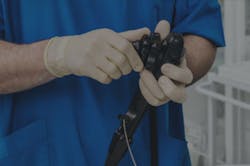Tips, tricks for inspecting endoscope cleanliness
Donna Swenson, President and CEO, Sterile Processing Quality Services Inc., Stickney, IL
Like any other reusable medical device, endoscopes should be inspected for cleanliness after the cleaning process. All devices should be tested using a lighted microscope, either manual or electronic. Electronic magnifiers will show a picture on a computer screen and usually are able to magnify to a higher degree than can a manual magnifying glass. Another tool to use is a borescope. This device can be used to see inside channels that are too small to see inside with the naked eye. Without a borescope it is impossible to inspect these lumens for visual cleanliness.
In addition to using devices that improve the ability to inspect for visual cleanliness it is possible to use test devices that can determine if any residue has been left on the medical device. These include devices that can check for protein and hemoglobin residuals and the presence of ATP. Even when a device may appear to be visually clean there can be residuals that may impede a disinfection or sterilization process.
Mary Ann Drosnock, MS, FAPIC, CIC, CFER, RM (NRCM), Manager, Clinical Education for Endoscopy, Healthmark Industries, Fraser, MI
- Visual inspection is the minimum that must be performed after the cleaning process and prior to disinfection or sterilization.
- Inspection with lighted magnification is becoming the new standard of care for inspection of instruments after the cleaning process. Most standard- and guideline-setting organizations now recommend inspection with lighted magnification in addition to the unaided visual inspection.
- Use of a borescope to inspect lumened instruments is now a recommendation in AAMI ST91 and AORN endoscope reprocessing guidelines. Although it is not a requirement at this time, use of borescope allows for visualization of the internal lumens of instruments including endoscopes. Retained debris, moisture and damage can be noted inside the lumens/channels of instruments through use of a borescope for inspection.
- Ensuring that your facility has proper lighting in the inspection area is crucial. Proper lighting allows for better visual inspection. Refer to AAMI ST91 for more information on proper lighting of inspection areas for endoscope reprocessing.
- Cleaning verification testing is performed after manual cleaning prior to disinfection or sterilization. Use of cleaning verification testing, such as tests for protein, carbohydrate, hemoglobin, etc., allow for facilities to check the cleanliness of the internal channels of the scope. These tests can provide you alert you to possible residual contamination after cleaning, which would be a warning sign of issues.
Crit Fisher, Director, Field Ops, Protection1, KARL STORZ Endoscopy-America Inc.
To help ensure thorough cleaning and be certain that the instruments has not been damaged, the following steps can be taken:
- Pay particular attention when examining the proximal and distal windows of the endoscopes, and wipe with alcohol.
- Ensure that the equipment is completely disassembled during cleaning.
- Use a loupe of appropriate magnification to examine the instrument for residue or other issues.
- Administer one last flush of air through the working channel.
- When inspecting rigid endoscopes for optical function, look closely at printed words to ensure the image is clear and sharp, and not at items across the room which will appear fuzzy at such a distance.
Brianne Flesher, Flexible Scope Division Manager, Mobile Instrument Service & Repair Inc., Bellefontaine, OH
- Rapid biological indicator tests with negative results allows for confirmation of cleanliness against materials that can’t be seen with the naked eye, i.e. biofilm.
- Magnification of distal end of scope to adequately check all small crevices and openings.
- Visual verification of inside working/biopsy channel to ensure all gross debris has been cleaned effectively, which can be done through small borescopes used for inspection.
- Verify that appropriate levels of enzymatic cleaner were utilized during pre-cleaning.
- Inspect all accessories for any residual debris prior to reprocessing with device.
About the Author
Rick Dana Barlow
Senior Editor
Rick Dana Barlow is Senior Editor for Healthcare Purchasing News, an Endeavor Business Media publication. He can be reached at [email protected].





